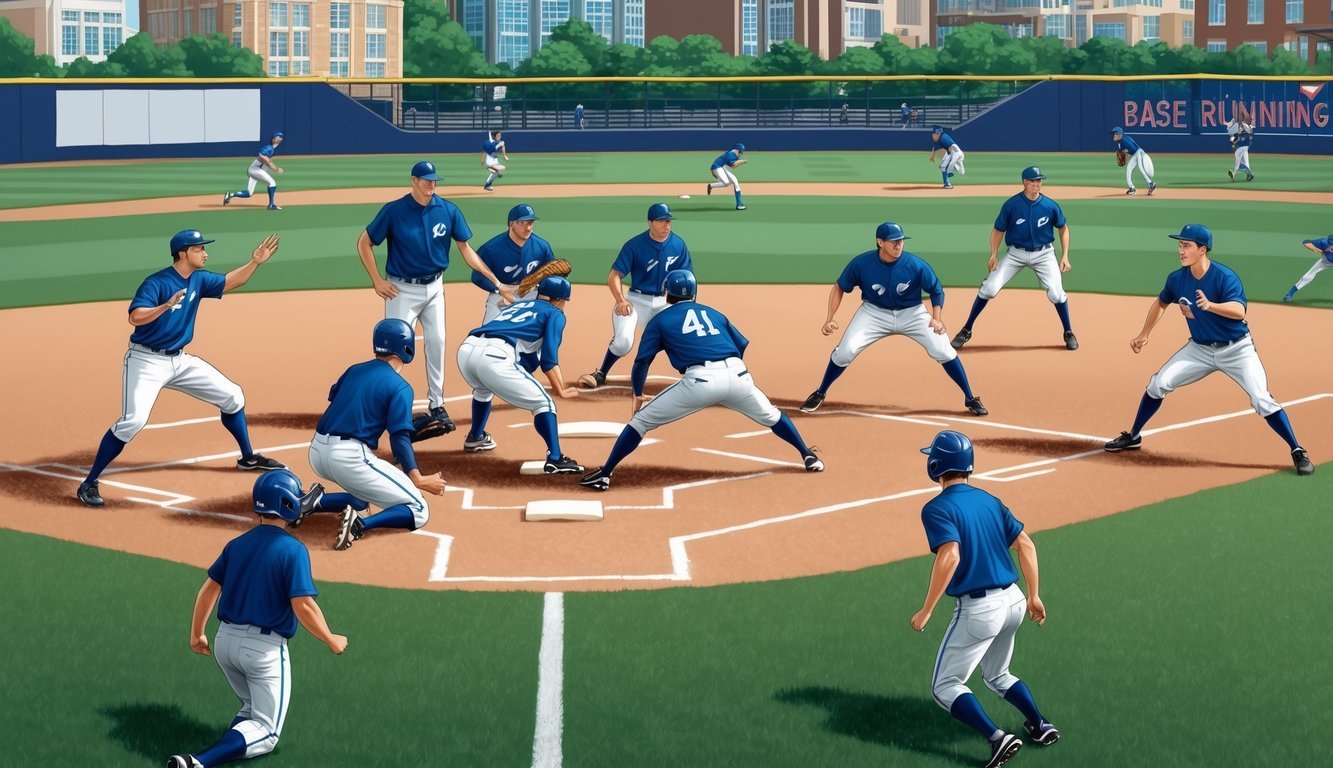Base running is an essential skill in baseball that can make or break a team’s offensive success.
It requires a combination of speed, agility, and strategic thinking to navigate the diamond effectively.
Mastering base running techniques can significantly impact a player’s ability to score runs and put pressure on the opposing team.
Good base runners possess the ability to read pitchers, anticipate plays, and make split-second decisions.
They know when to take an extra base, when to hold up, and how to slide to avoid tags.
These skills are honed through practice and experience, with players learning to react instinctively to various game situations.
Effective base running goes beyond just speed.
It involves understanding the game, analyzing the defense, and taking calculated risks.
A skilled base runner can turn a single into a double, advance on a fly ball, or steal a crucial base to set up a scoring opportunity.
By improving their base running abilities, players can become more valuable assets to their teams and contribute to winning games.
Fundamentals of Base Running
Base running is a crucial skill in baseball that can make or break a game.
Mastering the fundamentals requires a combination of technique, speed, and strategic thinking.
Understanding the Basics
Proper running form is essential for effective base running.
Players should lean slightly forward, pump their arms, and take quick, short steps when starting from a base.
Rounding bases requires a wide arc to maintain momentum.
Runners must always be aware of the ball’s location and the fielders’ positions.
This awareness helps in deciding when to advance or retreat.
Sliding is another key skill – feet-first slides are common for safety, while head-first slides can be faster in certain situations.
Reading the pitcher is crucial.
Runners should watch for tell-tale signs of a pickoff attempt or a pitch to home plate.
Quick reactions can mean the difference between being safe or out.
The Role of Endurance and Fitness
Base running demands both speed and stamina.
Players need explosive power for quick starts and sprints between bases.
Short-distance speed training is vital for improving base-to-base running times.
Endurance comes into play during long innings or extra-inning games.
Runners may need to sprint multiple times in quick succession.
Cardiovascular fitness helps maintain performance throughout the game.
Strength training, particularly for the legs and core, can improve a player’s base running ability.
Strong legs provide the force needed for quick starts and direction changes.
A solid core helps with balance and agility when rounding bases or sliding.
Flexibility exercises can reduce injury risk and improve overall running form.
Agility drills enhance a runner’s ability to change direction quickly, which is crucial when avoiding tags or retreating to a base.
Advanced Techniques and Strategies
Mastering advanced base running skills can give players a significant edge on the basepaths.
These techniques require practice, quick decision-making, and keen observation of the game situation.
Stealing Bases and Reading the Pitcher
Successful base stealers excel at reading pitchers’ movements and tendencies.
Watch for subtle tells in the pitcher’s stance, grip, or head position.
Pay attention to pickoff frequency and timing.
Practice your lead-off, ensuring a balanced, explosive starting position.
Take an aggressive secondary lead once the pitcher begins their motion.
Accelerate quickly, using short, powerful strides.
Develop a burst of speed in the first few steps.
This initial acceleration is crucial for beating the catcher’s throw.
Work on your reaction time by having a teammate simulate different pitching motions.
Additionally, focus on your footwork to ensure you’re taking optimal angles toward the base, as this can make a significant difference in the race to reach it.
Practicing these skills consistently will enhance your overall performance on the field and contribute to your success in critical moments.
For more insights, check out various baseball game improvement tips that can elevate your performance even further.
Taking Extra Bases
Taking extra bases requires sharp instincts and constant awareness.
Always know the game situation, including outs, score, and fielders’ positions.
Be ready to advance on any batted ball or wild pitch.
Read the ball off the bat quickly.
On ground balls, watch the fielder’s body language to anticipate errors or slow throws.
For fly balls, tag up and be prepared to advance if the catch is made deep or off-balance.
Communicate with your base coach, but trust your instincts.
Make decisive moves – hesitation can cost you a base.
Practice rounding bases smoothly to maintain speed when advancing.
Sliding and Avoiding Tags
Proper sliding technique is essential for safe and effective base running.
Practice feet-first slides, keeping one leg bent and the other extended.
Aim for the back corner of the base to avoid tags.
For head-first slides, keep your arms extended and fingers up to protect your hands.
Use this slide sparingly due to injury risk.
Learn to hook slide around tags by reaching for the base with your hand or foot.
Practice pop-up slides to quickly regain your feet after reaching base.
This allows you to potentially advance on overthrows.
Work on different sliding angles to evade tags from various directions.
Physical and Mental Training

Successful base running requires a combination of physical fitness and mental acuity.
Developing both aspects through targeted training can significantly improve a player’s performance on the basepaths.
Developing a Training Program
A well-rounded training program for base running should focus on building endurance, speed, and agility.
Start with regular cardio exercises like running and cycling to improve overall fitness.
Incorporate strength training, especially for the lower body, to enhance explosive power.
Agility drills are crucial for quick directional changes.
Set up cone drills to practice sharp turns and sudden stops.
Include ladder drills to improve footwork and coordination.
Don’t forget about flexibility.
Regular stretching helps prevent injuries and increases range of motion.
Consider adding yoga or Pilates to your routine for better body control and balance.
Incorporating Speed Work and Interval Training
Speed work is essential for base runners.
Fartlek runs are an excellent way to build both speed and endurance.
Alternate between sprinting and jogging during these sessions to simulate game situations.
Interval training can significantly boost a player’s acceleration and top speed.
Try short sprints of 10-30 yards with brief rest periods in between.
Gradually increase the number of repetitions as fitness improves.
Hill sprints are another effective method for developing power and speed.
Find a moderate incline and sprint up for 10-15 seconds, then walk back down.
Repeat this 5-10 times per session.
Mental toughness is equally important.
Practice visualization techniques to stay focused during high-pressure situations.
Incorporate reaction drills to improve decision-making skills on the basepaths.
Working with Coaches and Teammates

Effective base running relies heavily on teamwork and communication.
Players must work closely with coaches and teammates to make smart decisions on the basepaths and gain a competitive edge.
The Importance of a Base Coach
Base coaches play a crucial role in guiding runners.
They provide valuable information about the defensive alignment, potential plays, and optimal times to advance.
A skilled base coach helps runners read the pitcher’s movements and signals when to steal.
They also alert runners to pick-off attempts and relay signs from the dugout.
Players should maintain eye contact with their base coach and respond quickly to their instructions.
This partnership can make the difference between being safe or out on a close play.
Communication with Fielders and Baserunners
Clear communication between baserunners is essential for avoiding collisions and maximizing opportunities.
Runners should call out “going” when advancing to alert teammates.
They must also listen for calls from other baserunners and outfielders to avoid running into outs.
Runners should be aware of the catcher’s position and arm strength when considering stealing.
Reading the pitcher’s tendencies together can help runners time their jumps perfectly.
Baserunners can also work together to distract fielders and create scoring chances.
Constant chatter and awareness keep everyone on the same page during fast-paced situations on the bases.
Game Situations and How to React

Base running requires quick thinking and adaptability.
Players must stay alert and make split-second decisions based on the game’s flow and defensive positioning.
Strategies for Rounding Bases
When rounding first base, runners should take a wide turn while keeping an eye on the outfielder.
This allows for a smoother transition to second if the ball gets past the fielder.
On a hit to the outfield, runners should touch the inside corner of the base with their right foot.
This technique maintains momentum and provides a clear view of the play.
For extra-base hits, runners must be aggressive yet smart.
They should run hard out of the batter’s box, anticipating the opportunity to take an extra base on any defensive miscues.
Dealing with Pick-Offs and Fly Balls
When runners lead off, they must stay vigilant against pick-off attempts.
A balanced, athletic stance allows for quick retreats to the base.
Runners should study pitchers’ moves to gain an edge.
On fly balls, runners must quickly decide whether to tag up or retreat.
If tagging up, they should position themselves behind the base, ready to sprint as soon as the ball is caught.
For shallow fly balls, runners should take a few steps back toward their original base.
This positioning allows them to advance if the ball drops or quickly return if it’s caught.
Wild pitches and passed balls present scoring opportunities.
Runners should be prepared to advance, keeping their eyes on the ball and reading its trajectory off the backstop.
